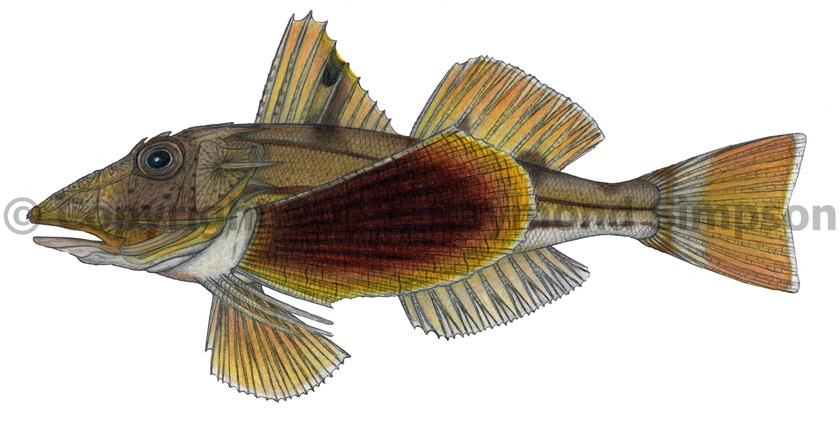
Common Name
Striped Searobin
Year Described
Linnaeus, 1766
Identification
Dorsal Fin: X, 12
Anal Fin: 10
Pectoral Fin: 13-14
Gill Rakers: 17-24 (first arch)
Body robust (noticeably heavier looking than congeners) but elongate and slightly compressed . Head is large, bony, and heavily sculptured with pronounced ridges and spines. Head profile sloped and not very steep. Duck-billed snout is long. Mouth is subterminal and large in size, containing bands of villiform teeth on the jaws, vomer, and palatines. Jaw reaches front edge of orbit. No spines at nostrils. Preopercle and opercle usually bear strong spines. Preopercular spine reaches beyond opercle. Large, fan-like pectoral fins with strongly branched rays, with the lower three rays free, thickened, and separate from the fin membrane. Pectoral fin viewed from above asymmetrically rounded (more blunt anteriorly). Pectorals when folded reach rear of anal fin base. Two dorsal fins: one spiny and one soft rays. Anal fin opposite soft dorsal fin. Caudal fin is truncate. Pelvic fin underneath pectoral fin on belly. Body covered in small ctenoid scales. Throat to area in between pelvic fins scaled. Nape scaled. Opercular membrane above spine partially scaled. Lateral line is continuous.
Color
Body brown with scattered faint spots and blotches, grading to white on the belly. Two dark brown stripes on the side of the body (one along lateral line and one on flank). Sometimes with a few incomplete brown bands under dorsal fins. Head plain or with dark brown spots and blotches. Spiny dorsal fin plain brown with an ocellated black spot between spines 4-6 (fading in large adults). Soft dorsal brown with a thin white edge. Pectoral fins reddish brown with paler rays and fine brown striations across the rays. Posterior 2/3 of fin with black crossbands of spots and a large blackish median area. Anterior third of fin plain brown. Edge of whole fin white. Free rays plain tan colored. Anal and pelvic fins plain with white edges. Tail tricolored with reddish brown, gray and reddish brown bands and a white rear edge.
Size
Maximum size to 45cm SL.
Habitat
Soft bottoms from 9-180m (usually 18-64m).
Range
Nova Scotia to eastern Florida. Continental coasts only.
References
Richards, W. J. & G. C. Miller. 2003. Triglidae (pp. 1266-1277). In: Carpenter, K. E. (ed.) 2003. The living marine resources of the Western Central Atlantic. Volume 2: Bony fishes part 1 (Acipenseridae to Grammatidae). FAO species identification guide for fishery purposes and American Society of Ichthyologist and Herpetologists Special Publication No. 5. FAO, Rome. v. 2: i-vii + 602-1373.
Other Notes
This species and Prionotus tribulus have a noticeably different body and head shape (wider body, bigger and smoother looking head, more gradually sloping snout) than other members of the genus in the area.